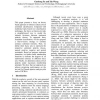1096 search results - page 98 / 220 » Computation Slicing: Techniques and Theory |
ISMB
1994
15 years 12 days ago
1994
Adaptive resonance theory (ART)describes a class of artificial neural networkarchitectures that act as classification tools whichself-organize, workin realtime, and require no ret...
ECCC
2007
14 years 11 months ago
2007
We introduce the notion of a Canonical Tester for a class of properties on distributions, that is, a tester strong and general enough that “a distribution property in the class ...
103
Voted
JACM
2010
14 years 9 months ago
2010
A temporal constraint language is a set of relations that has a first-order definition in (Q, <), the dense linear order of the rational numbers. We present a complete comple...
ACMSE
2010
ACM
14 years 9 months ago
2010
ACM
Developing software from models is a growing practice and there exist many model-based tools (e.g., model editors, model interpreters) for supporting model-driven engineering. Eve...
COLING
2010
14 years 6 months ago
2010
This paper presents a fuzzy set theory based approach to Chinese sentence-level sentiment classification. Compared with traditional topic-based text classification techniques, the...


